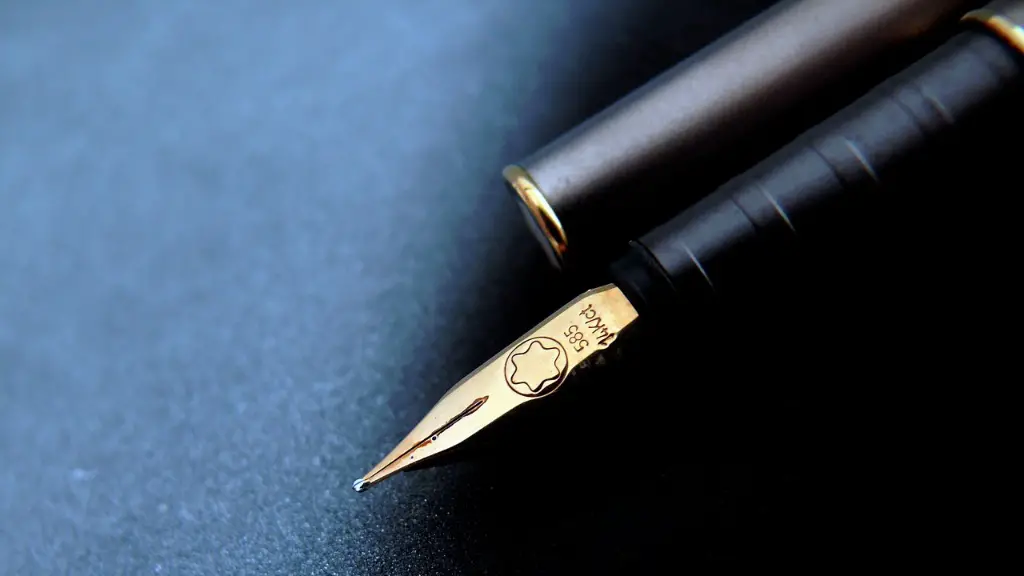Understanding the Elements of Poetry
For any reader to analyze a poem, he or she must have a clear understanding of the various poetic elements. These include meter, which refers to the rhythmic pattern expressed by the poet, diction, which is the style, format, or language the poet chooses to use, imagery and symbolism, which are the images or metaphors associated with the poem, and point of view, which is the perspective from which the poem is told. Additionally, readers should consider the poetic style, such as whether the poem is a sonnet, haiku, or a long rhyming poem. All of these elements affect how readers should interpret and analyze a poem.
Determining the Meaning of the Poem
When analyzing a poem, readers should strive to interpret the poem and find its inner meaning. They should ask questions of the poem, such as ‘What is the theme of the poem?’ Or, ‘What emotions are expressed in the poem?’. Readers can also draw conclusions by examining the structure of the poem and looking for patterns. All of these elements will help readers interpret and analyze the poem.
Identifying Literary Devices Employed in the Poem
Another important step in analyzing poetry is to identify the literary devices used. For instance, a poem may use alliteration, which is the repetition of similar sounds, or allegory, which is a story that has an underlying meaning or moral. Additionally, readers should consider how metaphors, similes, and rhymes are used, as these devices help convey the poet’s intended meaning. By looking for these devices, readers can gain a further level of understanding when interpreting and analyzing a poem.
Exploring the Context of the Poem
When analyzing poetry, readers should also consider the context of the poem. That is, the time, place, and situation in which the poem was written. Understanding this information could help readers better interpret the poem and its themes. For instance, poets often express their beliefs, values, political beliefs, and emotions through their work. By understanding the context of a poem, readers can gain further insight into the poem’s message and meaning.
Analyzing Figurative Languages Used in the Poem
When analyzing a poem, observers should pay special attention to the figurative languages used. This includes examining the different metaphors and symbols employed by the poet to convey his or her ideas. Additionally, readers should determine how rhyme and rhythm are used to both illustrate and contrast the theme of the poem. By understanding the use of figurative language, readers can gain an even deeper level of insight into the poet’s intended meaning.
Approaching the Poem with an Open Mind
Readers should approach the task of analyzing a poem with an open mind. That is, they should not come to the poem with any preconceived assumptions or ideas. Rather, they should approach the analysis with the intention of understanding the poem’s true meaning and its message. By maintaining an open mind, readers can draw more useful and meaningful conclusions when analyzing a poem.
Considering the Author’s Intention
When analyzing a poem, readers should also keep in mind the author’s intention. This means thinking about what the poet wanted to convey in the poem. Readers should try to understand why the poet chose certain words, images, or symbols, as well as how he or she combined them to create a particular effect. By considering the author’s intention, readers can better interpret the poem and its underlying message.
Exploring Other Interpretations of the Poem
When analyzing a poem, readers can also explore different interpretations of its meaning. That is, they should consider how other readers may have a different perspective on the poem’s message. Analyzing a poem from different points of view can help readers gain a more comprehensive understanding of its themes and meanings. It can also make the poem more meaningful and thought-provoking.
Getting Feedback on the Analysis
Finally, readers should seek out feedback on their analysis of a poem. This might include discussing the poem with friends, family, teachers, or other poets. By getting an objective opinion on their analysis, readers can further refine their understanding of the poem and its message. Additionally, they can be exposed to different interpretations, which could ultimately help them gain a deeper appreciation for the poem.
Using Supportive Evidence to Justify the Interpretation
When analyzing a poem, readers should also strive to provide supportive evidence for their interpretations. This could include citing specific lines or passages in the poem that illustrate the reader’s point. By demonstrating how the poem’s language supports the reader’s understanding, he or she can make their analysis more persuasive and effective.
Organizing and Structuring the Analysis
In order for readers to effectively analyze a poem, they must have a clear structure and organization to their approach. This includes having an introduction, main body, and conclusion to the analysis. Additionally, readers should consider including an outline that breaks down their analysis into sections and subsections. With an organized and structured approach to analyzing a poem, readers can increase the clarity and effectiveness of their interpretations.
Applying Their Own Experiences to the Poem
Finally, readers should consider how their own experiences and ideas can inform their analysis of the poem. That is, they should strive to connect the poem’s theme and message to their own life. Doing so can help readers gain a deeper understanding of the poem’s meaning by relating it to their own ideas and emotions. Additionally, it can make the poem more meaningful and powerful.



